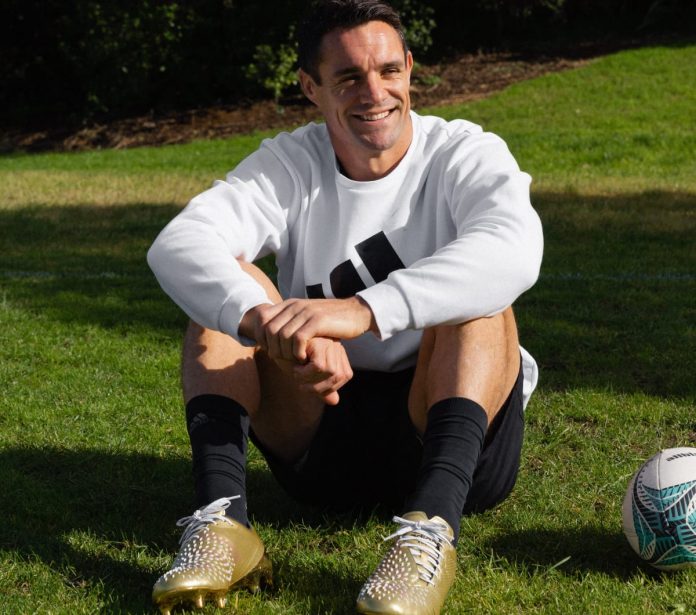Technology
In association with
The rugby star tells Newsroom how he and some of the biggest names in NZ art and music are launching the country’s first online dealer gallery for NFT creations – a new and potentially lucrative digital marketplace
Quiz question: What links Snoop Dogg, Tiger Woods, Paris Hilton, Damien Hirst and – soon – our very own former rugby supremo and pin-up hero Dan Carter?
Answer: NFTs, or non-fungible tokens. NFTs are a big thing in the crypto space, a digital certificate of ownership for unique, mostly virtual, artworks. Works that are being created by an increasing assortment of artists, musicians, sportspeople, and celebrities.
Now, former All Black star Dan Carter reveals to Newsroom that he and a small group of business high-fliers are launching a Kiwi-owned NFT studio and marketplace named Glorious, to deal largely in high calibre, exclusive works for collectors and art and music lovers, he says.
“There are exciting new commercial opportunities for athletes. When you are playing it’s so easy – you can grow your brand by your performance. But after you finish that, some people have an appetite to continue.”
– Dan Carter
They have already signed up big names including musicians Neil Finn, Six60 and Nathan Haines, and artists Dick Frizzell, Lisa Reihana, Heather Straka, and just this week, the estate of one of New Zealand’s most distinguished artists Rita Angus, who died in 1970.
Around the world, NFTs range from the sublime – real artists making cutting edge original works – to the ridiculous sight of nodding alpaca Gifs, or Paris Hilton’s very amateur digital drawing of her cat.
But they are all bought and sold using cryptocurrencies, and stored with their unique ownership identifier on the blockchain. And they are increasingly big business.

Not just for the digital artist Beeple, who in March sold an NFT of his work at Christie’s auction house for $100 million, catapulting him into the top three richest living artists.
Or for a twelve year old British boy who created and sold 3350 digital pictures of weird whales and made close to $600,000.
Or even for Paris Hilton whose drawing of Munchkin netted her (or at least the charities of her choice) US$17,000 (NZ$24,000).
NFTs are increasingly being seen as a credible way for artists and musicians to fund their creativity in a digital era, and for sportspeople (and celebrities) to get close to their fans and cash in on their brand.
A better class of NFT
Carter promises there won’t be any celebrity cat pics on the Glorious platform, which is to launch in late October. They will be, he says, “NFTs with high artistic and experimental value.”
There are two main benefits of NFTs over more traditional ways of creating and selling works, says Glorious co-founder and chief executive Tim Harper.

The first is creative: the opportunity for artists to experiment with digital media and for the collectors to have easier access to digital works.
But almost more important is creating a platform where artists can make money from their art.
An artist-centric commercial model
Traditional models, whether it be art galleries or music on Spotify can favour the platform over the artist, Harper says.
The Glorious model is different.
“We take 30 percent of the sale price, as against most galleries where it is closer to 50 percent.” More importantly, artists – and Glorious – continue to get a small tranche of the revenue each time a work is resold.

It’s a model that’s easy to enforce since each work has a unique digital ownership certificate linked to the original artist, so everyone on the Blockchain knows when it’s been onsold.
“The seller keeps 90 percent of the resale price, 7 percent goes to the artist and 3 percent to Glorious,” Harper says.
Which is a lot more than the nothing that mostly goes to an artist under the traditional model.
A crazy market
Particularly since over recent months resale prices for NFT works overseas have often gone up significantly – sometimes crazily so.
Just a few weeks after controversial UK artist Damien Hirst, of shark-in-a-tank-of-formaldehyde fame, sold 10,000 near-identical NFT dot paintings for $US2000 (just over $2800) apiece, the signed, numbered works are now changing hands for $75,000-$170,000.
It’s not clear how much Hirst will receive, but at a 7 percent resale margin that would be a minimum of $5000 for each of the 10,000 works – so far.
“I don’t want to use the word ‘mainstream’, but our intention is to make buying work as accessible to as many people as possible.”
– Tim Harper, Glorious
“Our goal is artist first,” Harper says. “How to use technology to do something incredible for artists.”
The New Zealand artists and musicians on the Glorious platform are still developing works for the launch, and for a potential platform group show afterwards, but Harper would like to see some affordable pieces.
“I don’t want to use the word ‘mainstream’, but our intention is to make buying work as accessible to as many people as possible.
“People who want to build digital collections or who have an interest in art should be able to get something for around $300 – our starting point. Then prices will go up to several thousand dollars.
Spending all that cryptocurrency
One of the peculiarities of the NFT market is that you can’t just rock up with your credit card to buy your work – sales are in cryptocurrency only.
That means a significant number of customers are cryptocurrency enthusiasts who may have made money – often a lot of money – from the rise in value of currencies like Bitcoin or Ethereum over the last five years.

The price of Ethereum, the cryptocurrency of choice for many NFTs, has gone up from less than $300 in early September 2019 to just over $4750.
Of course you can cash in your newfound cryptocurrency wealth. Or you can try to buy stuff with it, but to date there isn’t that much to spend it on.
Mostly you can’t pay for a coffee or a holiday in ethereum. But you can buy NFTs.
On the other hand, there are hurdles to non-crypto art lovers getting into NFTs. You’ve got to master the technology first.
“For a long time people struggled to come up with day-to-day uses for blockchain. NFTs is one of them.”
– Campbell Pentney, Bell Gully
And that’s isn’t always simple, says cryptocurrency expert and tax specialist Campbell Pentney from law firm Bell Gully.
Pentney is a big fan of the crypto world and of NFTs. “For a long time people struggled to come up with day-to-day uses for blockchain. NFTs is one of them,” he says.
Still there are pitfalls. Not only do you have to get hold of crypto, but often NFTs are linked with a particular platform, like Ethereum, meaning you have to have the right currency.
Meanwhile, the massive surge in popularity of NFTs has on occasions clogged up Ethereum, Pentney says, and pushed fees up.
Then there are issues like tax, where there isn’t a lot of guidance from IRD, which is still catching up with rules for blockchain.
Harper agrees NFTs can be frustrating to buy for people new to the blockchain game – in fact, the first time he tried to buy NFTs he says he found it a bit of a nightmare. But he says the Glorious team put that experience into the model when they developed the platform, trying to make it more user-friendly.
In terms of regulatory compliance, the company has Michael Heron QC, a former Solicitor General and chief executive of the Crown Law Office, as chair of the Glorious board.
“He provides authority and security as we navigate regulations around the crypto space,” Harper says.
From kicker to crypto
And Carter? What took one of the world’s most successful rugby players, with 112 All Blacks games under his belt, into the world of art and cryptocurrencies?
Carter says before announcing his retirement in February he was already looking around for business opportunities, particularly in technology. He was introduced to Harper and his long time creative partner Murray Thom by another of the co-founders, PwC’s Scott McLiver .
“What inspired me was what NFTs can do with athletes and their connection with fans,” Carter says.

“Something that jumped out was NFTs are a way for athletes to build community with the fans that have supported us.”
As well as being an investor (Carter, his wife Honor and lawyer Paul Calder hold a 13 percent share in Glorious) Carter is developing a side strand of the business focusing on sports-related NFTs.
The company has already developed a relationship with yachting competition SailGP, which is developing its own NFTs, and Carter is looking for others, including in the rugby world.
“The world of NFTs is new and evolving. Bringing fans closer to the artists or athletes they follow is at the core of the NFT experience.”
– Dan Carter
He is also working on his own NFT drops, though it’s early days in terms of knowing what a Dan Carter NFT series might look like, he says. Videos, photographs, memorabilia – there are a number of different models being tried by international athletes and codes.
In August, NFL star Tom Brady announced the launch of Autograph, a NFT platform that has signed up a raft of sporting stars including tennis star Naomi Osaka, gymnast Simone Biles and golfer Tiger Woods, but has little content as yet.
“There are exciting new commercial opportunities for athletes,” Carter says, including after their sporting career is over.
“When you are playing it’s so easy – you can grow your brand by your performance. But after you finish that, some people have an appetite to continue.”
In such a new space there are a lot of different options, he says, but early thoughts are to look at “moments” – digital images that also give buyers future benefits.
Think of buying an NFT work that also brings you exclusive fan benefits in the future. Like the right to kick a rugby ball around with Dan Carter, for example, or get a front row seat at some rugby matches. Or maybe there could be rights around limited edition gear, even digital trading cards.
“The world of NFTs is new and evolving,” Carter says. “Bringing fans closer to the artists or athletes they follow is at the core of the NFT experience.”
Still, with four boys under 10 at home, including a new baby, one can only imagine the chance to take advantage of the NFT boom and commercialise the Dan Carter brand wouldn’t be too bad either.
Credit: Source link





















 Bitcoin
Bitcoin  Ethereum
Ethereum  Tether
Tether  Solana
Solana  USDC
USDC  Lido Staked Ether
Lido Staked Ether  XRP
XRP  Dogecoin
Dogecoin  Toncoin
Toncoin  Cardano
Cardano  Shiba Inu
Shiba Inu  Avalanche
Avalanche  TRON
TRON  Wrapped Bitcoin
Wrapped Bitcoin  Bitcoin Cash
Bitcoin Cash  Polkadot
Polkadot  Chainlink
Chainlink  NEAR Protocol
NEAR Protocol  Polygon
Polygon  Litecoin
Litecoin  Internet Computer
Internet Computer  Uniswap
Uniswap  LEO Token
LEO Token  Dai
Dai  First Digital USD
First Digital USD  Ethereum Classic
Ethereum Classic  Hedera
Hedera  Aptos
Aptos  Stacks
Stacks  Mantle
Mantle  Cronos
Cronos  Stellar
Stellar  Cosmos Hub
Cosmos Hub  Filecoin
Filecoin  Renzo Restaked ETH
Renzo Restaked ETH  OKB
OKB  Render
Render  Immutable
Immutable  XT.com
XT.com  Pepe
Pepe  Arbitrum
Arbitrum  Bittensor
Bittensor  Maker
Maker  dogwifhat
dogwifhat  Optimism
Optimism  Wrapped eETH
Wrapped eETH  The Graph
The Graph 
